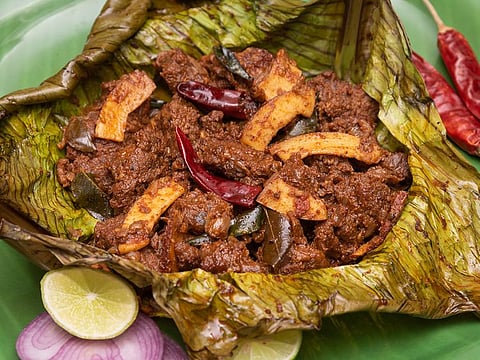Cooking with leaves: More than just an ingredient
8 recipes from Gulf News Food that use this traditional technique

Do you know what the Parsi patra ni machhi, the classic Kerala karimeen pollichathu and the Mexican tamales have in common? They are all cooked and served on a banana leaf.
In countries across Asia – especially India – cooking with leaves is an age-old technique, which was first introduced by our hunter-gatherer ancestors. Records show that it was during the Palaeolithic Period, when the Aurignacian people of southern France began to steam their food over hot embers by wrapping it in wet leaves.
Did you know?
The age-old technique of cooking food in leaves is also said to be the inspiration behind the French technique of en papillote (pronounced on-poppy-yote), where the food is placed in a folded pouch or parcel, and then baked.
Folded in half, wrapped into a cone or stitched together, these leaves are used to roast, fry, steam or even grill food. However, it was initially used as a storage medium, because it protected the food from being exposed to harsh heat and dirt.
It was only until much later, when the leaves’ full potential was discovered. When used in cooking, the leaves trap steam, seal in flavours, allowing the food to slow-cook in its own juices, absorbing the flavours of the leaf.
Same technique, different leaves
Several Indian medieval texts show records of food cooked in different types of leaves including turmeric, teakwood, jackfruit, banyan trees and the lotus plant. These leaves, are said to have been used based on regional and seasonal availability, which is why each state across India has a unique recipe that uses a leaf popular in that state.
According to scroll.in, “The Ni’matnama, a fascinating, albeit quirky, book of recipes put together by Ghiyath Shah, Sultan of Malwa, and his son Nasir Shah in the 15th century, archives recipes for kufta, or meatballs, folded in lime leaves and added to a broth. Other variations of the dish call for sour-orange leaves or even betel leaves.
“In another recipe, minced meat is spiced with cumin, fenugreek, cardamoms, cloves, camphor and musk, stuffed in screw pine leaves or in a basket made with sour orange leaves, cooked, and finally eaten with vinegar or lime juice. The Supashastra, which documents culinary traditions in medieval Karnataka, mentions a recipe for bamboo shoots ground into a paste with ginger, onion and grated coconut, stuffed in betel leaves and steamed.”
As for seasonal availability, let’s take the monsoon season in India for instance. Goan families feast on patholi or steamed rice rolls made with jaggery, while Odisha opts for the famed haldi enduri pitha or rice pancakes made with jaggery – both of which are made using turmeric leaves, which abound during the season.
Plantain leaves are available year round, and these too, are used to make several dishes. Kerala has the elayappam, which is popularly known as ada, or sweet rice pancakes with a jaggery-coconut or jackfruit (seasonal) filling. Gujarat has the panki, which is a savoury pancake and Tamil Nadu uses the banana leaf on a regular basis – from the traditional kozhukattai or steamed jaggery and coconut dumplings to sambar sadam or sambar rice.
Today, these green wraps are replaced with steel steamers and moulds, and these culinary traditions are now just a fond memory for many. However, recently, the use of leaves to cook food are regaining their popularity, for they come with several benefits.
Packed and cooked with benefits
The plantain leaves’ wax coating is said to be rich in natural antioxidants. Food served or wrapped in these leaves absorb the polyphenols present in the plants, thus making it a safe and hygienic option. Moreover, it is the very same wax that prevents dirt and bacteria from sticking onto the surface of the leaf.
However, there is a way to use plantain leaves, because they are quite brittle. The leaves need to be heated over an open flame, ahead of its use. Burning the leaves make them bendable and they release natural oils, which release a distinct aroma and shine. The wax present on the surface of a plantain leaf is also said to be the sole reason why food tastes good, when served in them. Steaming food wrapped in plantain, imparts a subtle yet sweet flavour as well.
Jackfruit leaves, which are popular in Bengal, are also quite rich in natural antioxidants and are believed to be effective in treating diabetes and helps control blood pressure. They are used as cones while making pitha or dumplings.
Each leaf has a distinct role to play when used in cooking, and its benefits have been seen for over 7,000 years. Today, this cooking practise has also found a key role in shaping the cuisines of Indonesia, where it is used in cooking methods called pepes and botok; and also in the Middle East and Mediterranean regions, where grape leaves are often used in the making of dolmas.
Also Read: Steamed fish in banana leaf
Also Read: This traditional recipe for steamed Kerala idli or rice cakes make for a great breakfast meal
Also Read: Tandoori prawns with lemon rice
Share your food stories and recipes with us on food@gulfnews.com
Sign up for the Daily Briefing
Get the latest news and updates straight to your inbox




